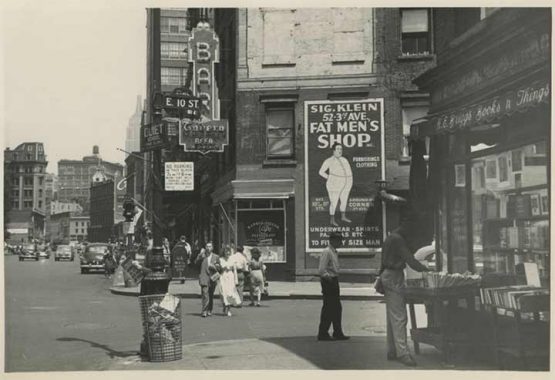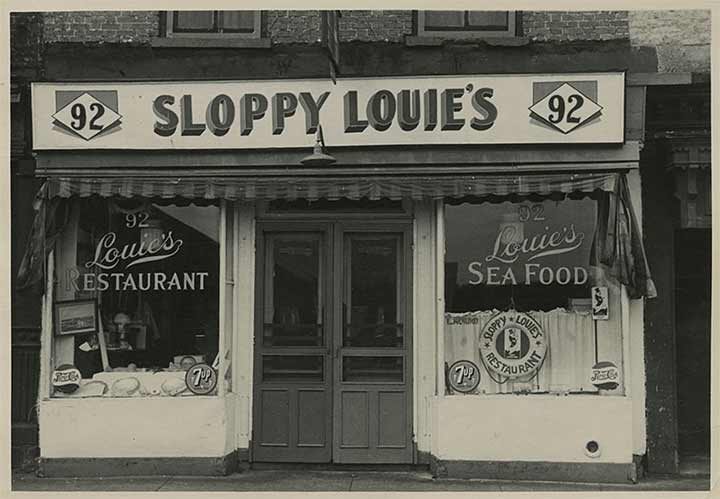
YOU’VE never heard of him, but Arthur Grumbine (1901-1998) was a formidable man. He began working as a telegraph operator beginning in 1918 for Philadelphia and Reading Railroad. He remained in that field, eventually taking a job with Western Union and rising in positions of increasing responsibility through 1943. On the side, he was an amateur photographer who built his own cameras and produced his own developing materials in the days when photography was much more difficult than pointing a box and pressing a button. In 1943 he embarked on a new career with the Photo Products Department of Dupont, where for the next couple of decades he racked up twenty international patents to his name. His work was primarily centered in commercially produced film for the pre-computerized printing industry.
Grumbine never stopped doing amateur photography and was especially fond of NYC street scenes. While in his 90s, he donated his collection of photos taken from 1938-1960 to the New-York Historical Society; today, I’ll show a few of them with. few words of commentary.
Above is Sloppy Louie’s, the famed South Street Seaport restaurant at #92 South Street that I just missed out on, as it closed in 1998, the very year I began Forgotten NY photography.
Sloppy Louie’s occupies the ground floor of an old building at 92 South Street, diagonally across the street from the sheds. This building faces the river and looks out on the slip between the Fulton Street fish pier and the Old Porto Rico Line dock. It is six floors high, and it has two windows to the floor. Like the majority of the older buildings in the market district, it is made of hand-molded Hudson River brick, a rosy-pink and relatively narrow kind that used to be turned out in Haverstraw and other kiln towns on the Hudson and sent down to the city in barges. It has an ornamental tin cornice and a late-covered mansard roof. It is one of the handsome, symmetrical old east River waterfront buildings that have been allowed to dilapidate. The windows of its four upper floors have been boarded over for many years, a rain pipe that runs down the front of it is riddled with rust holes, and there are gaps here and there on its mansard where slates have slipped off. In the afternoons, after two or three, when the trading is over and the stands begin to close, some of the slimy, overfed gulls that scavenge in the market roost along its cornice, hunched up and gazing downward. — Joseph Mitchell, “Up In the Old Hotel,” 1952
In the story, Sloppy Louie’s owner Louis Marino took Mitchell upstairs to the shuttered rooms to see what was there. Flash forward several decades, and a manager at the South Street Seaport Museum explored the upstairs once again and found it more or less unchanged since 1952, with artifacts from decades prior.

4th Avenue and East 10th Street, looking north. I’ve always considered 4th Avenue something of a curio as it’s Manhattan’s shortest numbered avenue. Of course when it was mapped in 1811 it ran all the way north to the Harlem River, but pieces of it were renamed Park Avenue and Park Avenue South in the ensuing decades.
4th Avenue looks nothing like this now, with staid high rise apartments replacing this lively street scene. For more about Klein’s Fat Men’s Shop, see Vanishing New York. On the right is one of the many used book emporiums that formerly lined 4th Avenue between Cooper and Union Squares. I don’t think any of the buildings in this photo survive, needless to say any of the people.

In 1999, “Little Liberty” was still in place on the Liberty Storage warehouse on West 64th Street. The building was later sold, but the 37-foot-tall replica was saved and now resides in a parking lot at the Brooklyn Museum. In 1972, Esso became Exxon, at least in the United States.

A scene under a Manhattan el. I’m sorry I missed the Manhattan els, but believe me, I’m not sorry to have missed the days when I would have had to go around in a wool suit and hat, even on the warmest days.
As always, “comment…as you see fit.” I earn a small payment when you click on any ad on the site.
3/29/22


12 comments
I was under the impression that in 1811, the road we now know as the last remnant of Fourth Ave. was actually part of The Bowery Road, which extended up to Union Square, at which point it became Fourth Ave. I’m not sure when in time it was renamed and The Bowery terminated at Cooper Square.
Esso was all set to change its name to Exon until someone pointed out there was a senator by that name. Doubling the X served two purposes: it would reduce the confusion with the senator, and it would lessen the chance that the name would inadvertently have some offensive meaning because Maltese is the only language with the double-x formation.
Except for Hall of Famer Jimmy Foxx and Redd Foxx
Jimmy Foxx, yes. Redd Foxx’s real name was John Sanford.
Excellent selection of photos.
Fat Men’s Shop. Say it like it is! Stores and departments catering to the alternatively shaped use so many euphemisms now.
Since 2003, “Little Liberty” has stood outside The Brooklyn Museum.
the first photo is the Manhattan I used to know,though I was born in 1957
the city still more or less looked like that when I was young.I remember the
Sig. Klein fat mans shop sign cuz i passed it all the time in the early 70s.The one
that hung directly over the front door.Even back then that sign was over a
hundred years old.There was also some ladies of the evening around there that
resembled Edith Bunker.I know they were because they would tug at my sleeve and ask me
if I wanted a date when I walked by. Me! A sweet innocent lad of but 16 years
The owners of that Statue of Liberty used to let the local kids up in it.There was
a ladder inside it.Was before my time.
The last photo is a photographic portrait of a Reginald Marsh painting.The Elevated
and the Bowery must have been where they got the idea for Film Noir.All those
characters skulking around in the dark shadows of the Elevated.Especially
around Chatham Sq..
Speaking of film noir, watch this on weekends on TCM:
https://noiralley.tcm.com/?msclkid=05f485e6b10d11ecabbc66b0affafd73
Please! You would not have had to wear a wool suit in the summertime! You’d have worn a cotton suit, probably seersucker. And a straw hat, still commonly worn. Both very comfortable.
These are great photos, thank you. I remember Sloppy Louie’s, but not too well.
On a hot-enough summer day you probably might have gotten away with wearing an ice cream suit and a panama hat, like Charlie Chan, a resident of Honolulu and thus living in warm weather year-round, would have worn.
Near Sloppy Louie’s was another great restaurant – Sweets. Best seafood ever.